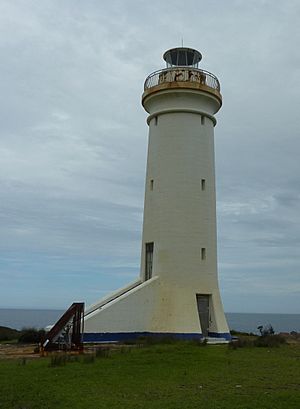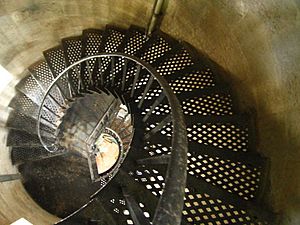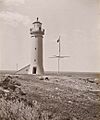Point Stephens Light facts for kids
 |
|
| Point Stephens Lighthouse | |
|
|
|
| Location | Point Stephens, Fingal Bay, Port Stephens Council, New South Wales, Australia |
|---|---|
| Coordinates | 32°44′48.95″S 152°12′4.16″E / 32.7469306°S 152.2011556°E |
| Year first constructed | 1862 |
| Automated | 1973 |
| Construction | Sandstone tower |
| Tower shape | Cylindrical tower with balcony and lantern |
| Markings / pattern | White tower and lantern |
| Height | 21 metres (70 ft) |
| Focal height | 38 metres (126 ft) |
| Intensity | 40,700 cd |
| Range | 17 nautical miles (31 km) |
| Characteristic | Fl (4) W 30s. |
| Admiralty number | K2770 |
| NGA number | 111-6052 |
| ARLHS number | AUS-138 |
| Australia number | |
The Point Stephens Light is an old and important lighthouse in New South Wales, Australia. It stands on a small piece of land called Point Stephens, which is part of Fingal Bay. This lighthouse helps ships find their way into Port Stephens. It is about 4.25 km (2.64 mi) south of the port's entrance.
This lighthouse is special because it's considered an "endangered" lighthouse. This means it's in a remote spot and is quite old. It was first suggested in 1857 and finished in 1862. The lighthouse and its old keeper's cottages have unique designs for their time.
Over the years, the light source changed many times. It started with kerosene lamps. Then it was updated to a Dalén light, then electric, and finally to solar power in 1990. In 1973, the lighthouse became automated, meaning no keepers were needed. Sadly, the keeper's cottages were damaged by vandals and fire in 1991.
The lighthouse tower looks like a Doric column. It has four floors with a spiral staircase inside. Today, the lighthouse is part of the Tomaree National Park. It's a bit tricky to get to, either by walking across a narrow sand spit at low tide or by boat.
Contents
History of Point Stephens Lighthouse
Lighthouses are super important for guiding ships safely. As early as 1857, people realized a lighthouse was needed at Point Stephens. This was because the coastline was dangerous, and sailors often confused Fingal Bay with the entrance to Port Stephens. Many ships had been wrecked here. For example, the Dove sank in 1828, and the Pandora in 1836, both causing loss of life.
The lighthouse was finally built in 1862. Its light was officially turned on for the first time on May 1, 1862. Alexander Dawson, the government architect, designed it. He gave it a unique flared base and an outside staircase. The lighthouse keepers' cottages were also special. They were built in a Victorian Gothic style. All three keepers shared the same roof and a combined terrace.
The first light used twelve kerosene lamps. These lamps were on a spinning frame. They showed alternating red and white flashes. The lighthouse needed three keepers to operate it.
In 1901, the keeper's homes were repaired. Their original slate roofs were replaced with terracotta tiles. In 1903, a report said the red flashes were hard to see. This made it confusing for ships. So, they decided to remove the red shades. The light then became a single white flash every minute.
Later, in 1922, the light was upgraded. It got a stronger Dalén light. This light was much brighter. The number of keepers was also reduced to two. In 1960, the lighthouse was connected to electricity. It even had a backup diesel generator.
In 1973, a new, smaller lantern was installed. The lighthouse became fully automated. This meant lighthouse keepers were no longer needed. The buildings were almost torn down. But, thanks to a campaign by locals and one of the last keepers, they were saved! The buildings were then leased to the National Trust of Australia.
In 1990, the lighthouse switched to solar power. This happened after the electric cable failed. The last caretaker left in March 1991. Sadly, by September 1991, vandals burned the keeper's cottages. In 1992, the site was cleaned up. A security fence was put in place.
In 1998, the lighthouse became part of the Tomaree National Park. It also got some much-needed repairs. The walls were cleaned and waterproofed. The spiral staircase was fixed. The lantern room was sealed to keep water out.
Today, the light uses a quartz halogen lamp. It flashes four times every thirty seconds. It can be seen up to 17 nautical miles (31 km; 20 mi) away.
Lighthouse Structures
The lighthouse tower is at the very end of Point Stephens. Its design is quite unique. It looks like a Doric column. It has a wide base that was used for storing equipment.
The tower walls are made of sandstone blocks. These blocks were brought by ship from Sydney. The walls are very thick at the bottom. Inside, the tower has four floors. These floors are connected by a spiral staircase. The ground floor used to store oil. Now, it holds the light equipment and a generator.
The original glass lantern was replaced in 1973. A new fiberglass lantern was installed. The old lantern is now kept by the Nelson Bay Historical Society.
The Keepers' Cottages
The keeper's house is about 13 metres (43 ft) north of the tower. It's the only example in Australia of a row of lighthouse keepers' homes built together. It was probably finished a little after the lighthouse.
The building had three cottages joined together. There was a six-room cottage for the main keeper. Two smaller cottages, with three rooms each, were for the assistants. All shared the same roof. Each cottage had a kitchen, a storeroom, and a toilet. The building was made from the same sandstone as the lighthouse. The roof was originally slate. In 1901, it was changed to terracotta tiles.
Water came from two large underground tanks. Sadly, as mentioned, the keeper's house was destroyed by fire in 1991. Only parts of the walls remain.
Other Buildings and Remains
Several other buildings were once behind the cottages. These included kitchens and storage areas. They were also destroyed in the 1991 fire.
A brick toilet building with a gabled roof is north of the cottages. It was likely built around 1930. Further north is a workshop building from the 1950s. This building once housed electricity generators. It was later used as a cabin for fishermen.
You can also see old drystone walls near the lighthouse. These date back to 1865. There are also remains of a flagstaff and a stone retaining wall. South of the lighthouse, there are two timber-framed buildings. One was a fuel shed from the 1970s. An old brick fuel bunker is also located on a rock.
At the north of the island, you can find remains of a 19th-century wharf. This includes concrete tracks and iron fittings. A concrete helipad was built west of the lighthouse in the 1970s.
Visiting Point Stephens Lighthouse
The Roads and Maritime Services operates the light. The National Parks and Wildlife Service manages the site. It is part of the Tomaree National Park.
Visiting the lighthouse can be a bit tricky. The point is connected to the mainland by a narrow sand spit. You can only walk across it at low tide. You can also reach the lighthouse by boat. The grounds are open to visitors. However, the lighthouse tower itself is closed to the public.
Why Point Stephens Light is Special
On April 2, 1999, the Point Stephens Lighthouse and its nearby buildings were listed on the New South Wales State Heritage Register. This means they are very important and need to be protected.
The lighthouse is special for many reasons. It combines the beauty of the coast with the history of a landmark. It's one of the few Victorian lighthouses designed by Alexander Dawson. Its sandstone tower with a flared base is unique. The old keeper's cottages, even in ruins, are important examples of early lighthouse housing. The site also has parts of the original lantern and offers a chance for archaeological study.
Images for kids






